Don't wanna be here? Send us removal request.
Photo
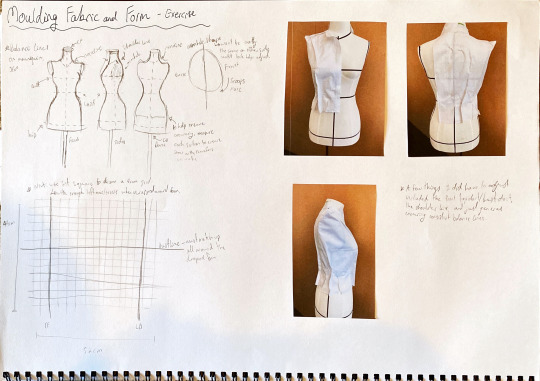
1 Draped block/moulding fabric and form exercise
0 notes
Text
4 Anxiety Line Drawing
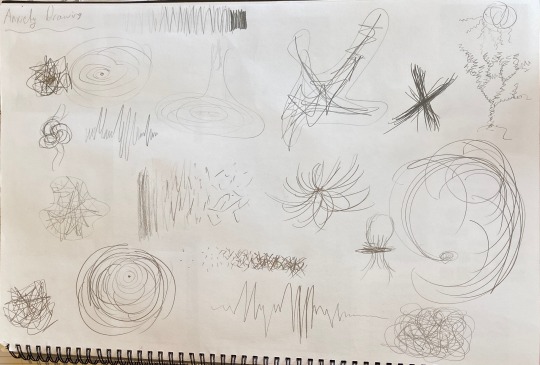
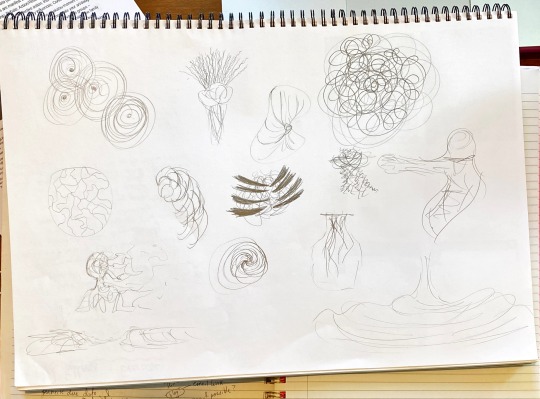
My line capture/anxiety inspiration drawings and sketches from the moodboard images I collected.
I focused largely on scribbles, ripples/circles/spirals as they came naturally and are easier to replicate from the images I found. They were also the images that I had thought of initially and focused on the most, the ripples, scribbles, and knots
What a lot of the sketches appeared to have in common was how they were tightly wound, or that there was a kind of restriction, with varying degrees of release (if there was any kind of release at all).
The sketch that I liked the most was the sharp, coloured in rib cage over the scribbles. I was inspired by the x-ray of the butterflies in the stomach.
When I looked at image, I thought it was interesting, except that I thought the anxiety was bigger and ‘uglier’/heavier than the butterflies, so when it came to the sketch, I drew scribbles to represent the knots from my other imagery.
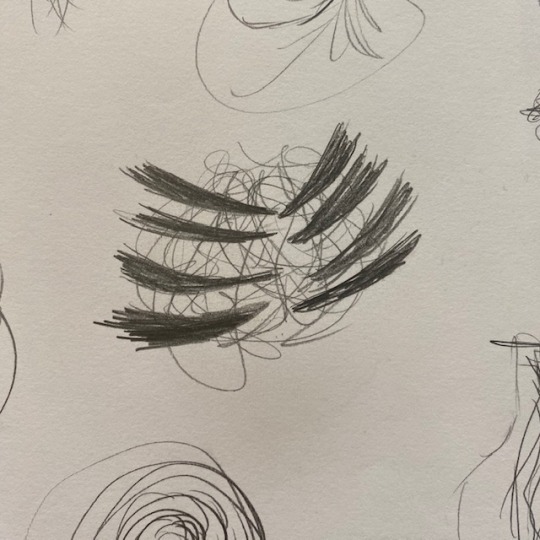
There was something about the sharpness of the ribs over the softer scribbles that really appealed. I also liked how this showed the contrast of external vs external - the x-ray allowing us to see inside whilst also seeing something trapped inside and such. Perhaps that because I could see multiple concepts relating to anxiety, and how I could work with this sketch that it appealed so much - that levels and depth of thought that it had the potential for.
0 notes
Photo
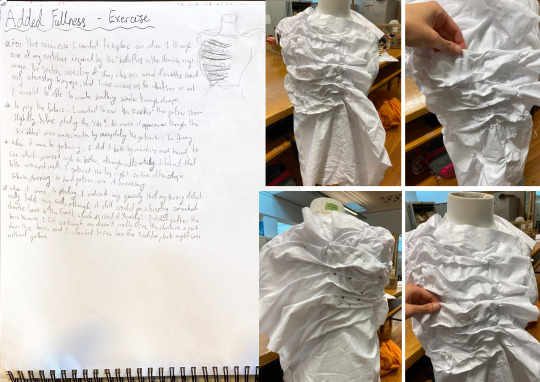
5 Added fullness exercise + concept drape exploration
0 notes
Photo
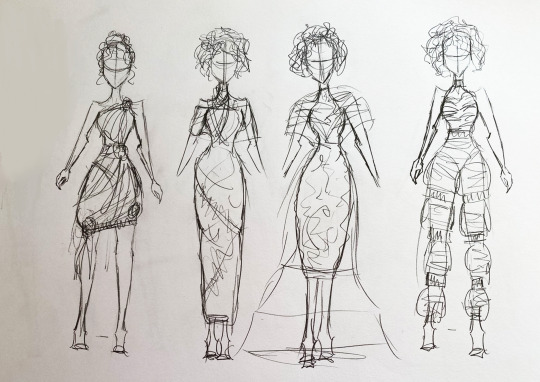
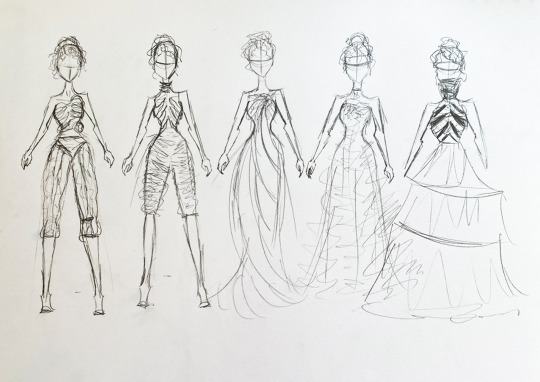
10 Drape Iterations
To use my drape as inspiration, I have drawn a few iterations following the general concept, as well as incorporating a few elements of the other anxiety line drawings/sketches. The main design elements I think are the constricted, tightness of the designs, the focus on the ribs/skeletal pleats, and some focus on the areas of anxiety - the heart and the stomach/gut.
0 notes
Text
12 Drape Summary
Design Aim
My design aim was to portray the emotion Anxiety through drape. To do this I looked at my own experiences and general knowledge of what Anxiety was and meant, collecting various imagery that I thought to be relevant. When it came to selection a specific visual, I ended up using the x-ray ribcage with butterflies inside. I chose this visual because of the line drawing/sketch I made I found to be visually striking, and I was able to see how it could portray the concept of Anxiety in multiple ways. The sharp ribcage acting as the invisible, unseen barrier and ‘cage’ that Anxiety is to the mind, as well as indicating this idea of internal vs external. And, because we can ‘see’ through the ribcage, we also get a glimpse of what the anxiety looks like inside. The original image had butterflies, which I perceived to be not the right representation of Anxiety, and so I replaced them with the scribble/knot imagery, to get across that feeling of a knot in ones stomach or gut.
And so, in theory, I would be largely portraying through my design the internal/external conflict of Anxiety, the ill feeling one gets from Anxiety, and the trapped feeling of Anxiety. In making theory into a toile, I think that the draped design outcome in portraying anxiety is reasonably successful. I did get the comment that it looked like quite a ‘pretty anxiety’, which did make me wonder if I had gone in the right direction. But perhaps this could show how anxiety doesn’t always look like anxiety, or perhaps that people don’t always recognise it - that one could indeed believe that the way they live is fine and are creating their own cage without realising. Nonetheless I think that my portrayal of anxiety is perhaps a bit more subtle than I intended.
If I were to take this further, I think that I would like to expand on this concept more, and make it feel/look more like anxiety. This would include using sheer fabric for a sharper looking ribcage which would then sit over the texture I created - which I think I could then exaggerate more, and use more knots and tight lines.
Context/market
If I were to look at the garment I intend to make, I see it as more conceptual and therefore leaning towards high fashion. I do wonder how it might be commercially sold, as the construction method, time and effort that has to be put into making the garment will also dictate what part of the market this garment would be sold in. Because I am not entirely sure how the replication of the pre-gathering may happen, it is highly likely that each piece could be slightly different, again leaning towards more couture techniques and high fashion. If there was a way to perhaps ‘map out’ the gathering stitches I used to create the initial texture before pleating my fabric, as well as gather said fabric consistently (which would also be dependant on what kind of fabric is used and it’s behaviour when gathered).
Coming back to the market, I think it would definitely be in mid-high fashion, and perhaps a bit more niche of a target market due to the skeletal aesthetic. I also believe that even though it is conceptual, a consumer wouldn’t necessarily have to understand the concept to buy it.
Process Evaluation
My process for this project in the practical sense started with the way in which I tackled the idea of my scribble-ribcage sketch. At this point I wasn’t sure if I would be using this idea for my final and I just wanted to experiment with said idea. After looking at what I was after I thought that the first aspect of the design, I decided to pre-gather my fabric to create the ‘scribbles’ - I would then go from there, manipulating the gathers as needed. Unfortunately, it was only after I had finished gathering the fabric that I realised I forgot to mark out the grain of the fabric. I couldn’t just un-gather the fabric, and it wouldn’t lie flat enough for anything I drew to be accurate. I therefore decided that I would use the selvage edge as my grainline marker (which later was not visible due to how I had draped the fabric).
When draping the fabric onto the body, I placed the salvage/straight grain parallel (as much as it could be on a 3D shape) to the bust and waist lines. From there I began adding fullness through pleats. These pleats were to represent the ribcage. I originally wanted them to be quite sharp and protruding from the form, but the way I’d gathered the fabric and the way the it reacted to the gathering meant that I couldn’t manipulate said gathering as much as I would have liked. I did, however, only gather the area for the front and side, leaving the back. I then decided to also drape the ribcage on the back without gathers to see what it might look like. This was indeed very sharp looking in comparison to the softer looking if somewhat chaotic looking front.
After adding the fullness I decided that even though it was a bit different to my original idea, as the pleats on the front were partially gathered, I still really liked it and could see lots of potential from this design idea. I therefore decided to continue developing this drape, and after consultation I honed in where I draped the fabric to areas more concentrated until I was satisfied. I did consider using a different/alternate fabric for the ribs, but ultimately left it out. This is because when I draped the alternate fabric on top, it didn’t add anything, and made the design look too busy.
In terms of notations, I didn’t get much time to do many physical notations, which was partially because I wanted to spend more time considering how the gathering might be taken into consideration and whether or not I note where I gathered the fabric before draping and how I gathered it, as said gasther varied. What I was also unsure about were the fact that the pleats were not the same width consistently - a single pleat would start out small, then become wide, then small again. Unfortunately I did not get the opportunity to navigate this.
When it came to the recommended construction sequence, again, the gathering of the fabric was a little ambiguous, so I had to make the assumption that the fabric was gathered before the pattern would be cut out from said fabric. Apart from that, the only major aspects of the construction were the adaptation to allow for boning, and how the hem might be finished due to the knot. Honestly, the only aspect I think needs to be sorted out physically would be the hem, as to adapt the lining for the boning seems simple enough. I didn’t really focus on any other finishings, as the construction meant that only the hem would be open. I do, however, recommend since the tie could be left out from the lining at raw edges (with a row of stitching 5mm from the edge) would be the best option. This is because the frayed, deconstructed hem adds to the Anxiety, and frayed rope/knots were a part of my inspiration.
Overall, I think my process was okay. I would like to have taken more note of grainlines, and drawn all of them in for my benefit in seeing how the gathers and pleats affected that. As well as this, if I had more time, I would have perhaps liked to experiment with more than one idea or at the very least not be too hesitant to change a current idea. This is largely in relation to how I did the ribs. I liked what I had already draped, and was reluctant to unpin and move it about too much, just in case I was not satisfied with the change and wanted to go back - that it was unlikely I would be able to precisely recreate the idea before the change. I also think that perhaps if time were not as pressed as it was with external pressures, I would have liked to experiment more with alternate fabrics for the ribcage, to push and exaggerate the idea more.
Conclusion
To conclude, I think that this project was overall successful. I believe that the garment I draped does represent the emotion of Anxiety through the gathering and the ribcage, if a bit more subtle than I would like. If I were to continue this project or make any design changes, I would like to see how I might push this concept further, and extend it beyond the waist/torso, as well as see how I could exaggerate it to make the Anxiety a bit more obvious.
If I were to do this project again, I would have liked to do more exploration. Perhaps found more images and visuals to draw from to allow more for design elements and shapes. I know this is about breaking from ‘traditional pattern making’ and designing iterations, but I would have liked to do some sketches of garments to help explore more possibilities and ideas beforehand, rather than sticking to the first I happened to put on the form.
0 notes








